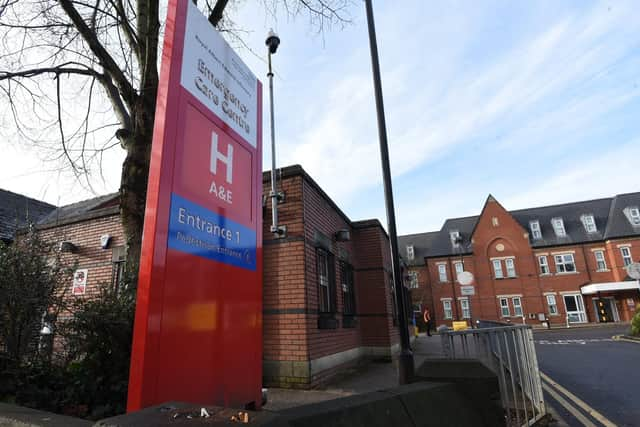Concerns grow for patient safety at Wigan hospital
and live on Freeview channel 276
Due to increased pressures, it has been reported that patients are being placed in fire exits or under draughty windows with no privacy or access to emergency equipment.
And staff are becoming “overwhelmed” forcing some to take long-term sickness leave.
Advertisement
Hide AdAdvertisement
Hide AdOne employee who wishes to remain anonymous said: “It is no secret the NHS is struggling, however does this condone placing a patient in a fire exit with no curtains for privacy, no nurse call bell and more to the point no emergency equipment?
“This situation is fast becoming the norm. Patients who are deemed the most fit are being placed in this pop-up bed underneath two draughty windows, with no privacy or dignity, butt up against a wall and blocking access to the fire extinguisher.
“The excuse that is given for this ‘well it’s better than being nursed on a corridor’, but two wrongs don’t make a right.
"Staffing on the A&E corridor is one nurse to four patients whereas the ratio on the ward is one to 14.
Advertisement
Hide AdAdvertisement
Hide Ad

"These increased pressures are causing staff to refuse and go on long term sick, which is then having a knock-on effect as they then put additional strain on their colleagues.
“I am not in the profession for the money, I am here because I love nursing but these pressures are becoming overwhelming and are making me ill.
Bosses at Wrightington, Wigan and Leigh Teaching Hospitals NHS Foundation Trust (WWL) today sought to reassure the public.
Interim chief executive Mary Fleming said: “Patient safety is our absolute top priority at WWL, and patient care is at the heart of everything that we do. We are sorry to hear of the concerns that have been raised regarding patient safety at Wigan Infirmary
Advertisement
Hide AdAdvertisement
Hide Ad“At times of extreme pressure, and when our emergency department is exceptionally busy, we would like to reassure the public that clear escalation plans are put in place.
"This may mean opening additional areas or beds that would not normally be used. In support of these plans, hospital full capacity protocols are implemented, and safety checklists are monitored through regular internal patient safety assurance meetings.”
New figures bear out the problems faced, revealing that nearly three in every five patients faced long waits to see a doctor at Wigan Infirmary A&E last month.
Hospitals across the country experienced high demand in January as winter took hold and junior doctors staged the longest strike in NHS history in their ongoing dispute over pay.
Advertisement
Hide AdAdvertisement
Hide AdNHS England said A&E and ambulance services experienced their busiest ever January.
Bosses at WWL have made repeated calls on social media for people to consider the best place to get treatment, with the busy A&E department only for those in a serious or life-threatening condition.
New data published by NHS England shows there were 12,712 emergency attendances in January – 7,464 at Wigan Infirmary’s A&E unit and 5,248 at Leigh Urgent Treatment Centre.
But just 42.1 per cent of people at A&E were seen within the four-hour target time. That was down from 46.9 per cent in December and 48.4 per cent in January last year, and was the lowest performance for at least nine years.
Advertisement
Hide AdAdvertisement
Hide AdFor the trust overall, 65.3 per cent were seen on time, as 98.4 per cent of patients were seen in four hours at the urgent treatment centre.
Nationally, 70.3 per cent of patients were seen within four hours in A&Es last month, up from 69.4 per cent in December.
The NHS recovery plan sets a target of March 2024 for 76 per cent of patients attending A&E to be admitted, transferred or discharged within four hours.
In Wigan, there were 2,934 emergency admissions, down from 3,191 in December, but many of these patients then faced long waits for a bed.
Some 1,668 patients waited more than four hours, down from 1,722 in December, while 512 people had a delay of more than 12 hours, up from 406 the month before.
Advertisement
Hide AdAdvertisement
Hide AdClaire Wannell, WWL’s interim chief operating officer, said: “Throughout January, WWL faced extraordinary pressures on our urgent and emergency care services, with emergency department (A&E Type 1) attendances exceeding 300 patients per day on a number of occasions and increased patient acuity due to the circulation of winter bugs and viruses.
“Intensified by the longest period of industrial action in NHS history by junior doctors between Wednesday January 3 and Tuesday January 9, and wards not able to accept new admissions due to infection prevention and control measures, this unfortunately meant that patients, particularly those triaged with less urgent conditions, experienced longer waits in our Emergency Department.
“Our clinicians will always prioritise those in most urgent need and we apologise to anyone waiting a significant period of time. Once again, WWL would like to thank the public for the support we have received during these times of extreme pressures.
“The public can help us by remembering that emergency departments should only be used for life-threatening illnesses and injuries and if you help in these situations, you must come forward.
Advertisement
Hide AdAdvertisement
Hide Ad"For conditions which are less urgent, please use NHS 111 or consider visiting a local pharmacy, Urgent Treatment Centre or GP practice for support instead.
"To further help us to continue to provide safe and effective care, we urge families and friends of patients who are ready to be discharged from our hospitals to support their loved ones to recover at home.
"Our discharge teams are working incredibly hard to make sure this transition is safe, and recovery at home is always the best option.”